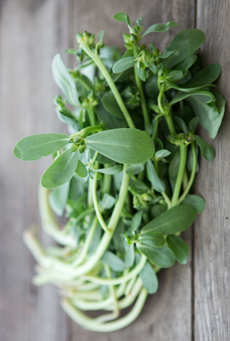TIP OF THE DAY: Purslane
|
Many of the greens we enjoy today began life as weeds. They showed up, uninvited, in gardens and fields. Given the scarcity of food, they were gathered and brought to the kitchen. While some of these intruders were distasteful (or even poisonous), others were welcome, including dandelion greens and mache (lamb’s quarters), which has become a “gourmet lettuce.” Perhaps the weed we eat the most is watercress, which grows wild alongside streams and riverbanks. Other weeds, like red clover, were turned into homeopathetic remedies. Such is the case of purslane (PURSE-lane, Portulaca oleracea), a low, trailing plant with yellow flowers that’s used for food and homeopathy. It looks like a baby jade plant (see photo) and tastes like a cousin of spinach or watercress. Purslane is not well known in the U.S., where most people see it as a common garden weed. But for those who decide to eat it rather than weed it, it is a delicious salad ingredient and potherb*. |
Wild purslane. Photo courtesy GoodEggs.com. |
|
|
Purslane, native to India and Persia, has spread throughout the world. Ancient Greeks and Aztecs ate it. Many modern cultures embrace it. Russians dry and can it for the winter. Mexicans (who call it verdolaga) enjoy it as a comfort food, in omelets, as a side dish, rolled in tortillas, in soups and stews. Europeans and Americans in-the-know use it in salads and stews. *Potherb refers to any plant prepared as food by cooking in a pot—spinach, for example—or any herb added as seasoning. It includes any part of the plant: flowers, leaves or stems. The seeds of a plant become…spices! Two tablespoons of olive oil per day have been shown in clinical studies to have a beneficial effect in reducing coronary disease. The claim has been approved by the FDA. |
||
 A Mediterranean salad with purslane. Recipe and photo from Kalyn’s Kitchen. |
Think of purslane as a weed, says a CSA that gathers it for customers, and you’ll be missing out on one of the most nutritious greens on the planet.
|
|
|
Purslane loves prefer to eat the young plants, especially young leaves and tender stem tips. Check out purslane recipes at PrairielandCSA.org.
|
||



